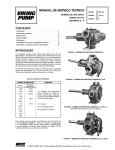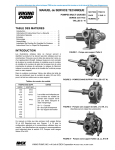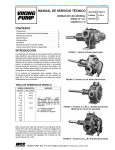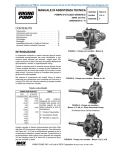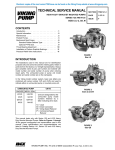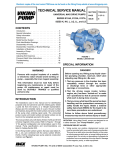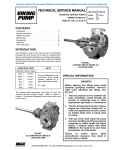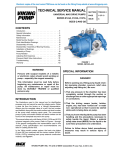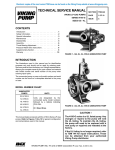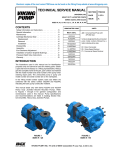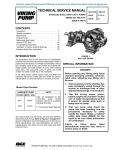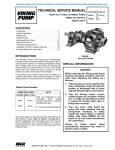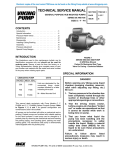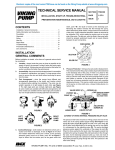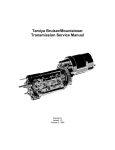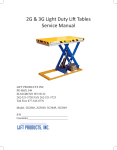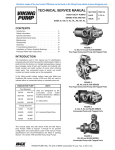Download TECHNICAL SERVICE MANUAL
Transcript
Electronic copies of the most current TSM issue can be found on the Viking Pump website at www.vikingpump.com TECHNICAL SERVICE MANUAL GENERAL PURPOSE PUMPS SERIES 32, 432 AND 32E SIZES G - N SECTION TSM 312 PAGE 1 OF 12 ISSUE H CONTENTS Introduction . . . . . . . . . . . . . . . . . . . . . . . .1 Special Information . . . . . . . . . . . . . . . . . . . .2 Maintenance . . . . . . . . . . . . . . . . . . . . . . .2 Disassembly . . . . . . . . . . . . . . . . . . . . . . .6 Assembly . . . . . . . . . . . . . . . . . . . . . . . . .6 Installation of Carbon Graphite Bushings . . . . . . . . 8 Pressure Relief Valve Instructions . . . . . . . . . . . 9 Heat Cartridges . . . . . . . . . . . . . . . . . . . . 10 INTRODUCTION The illustrations used in this manual are for identification purposes only and cannot be used for ordering parts. Obtain a parts list from the factory or a Viking® representative. Always give complete name of part, part number and material with model number and serial number of the pump when ordering repair parts. The unmounted pump or pump unit model number and serial number are on the nameplate. FIGURE 1 - G Size Unmounted Pump In the Viking model number system, basic size letters are combined with series number (32, 432 and 32E), indicating either an unmounted pump or mounted pump unit. Model Number Chart UNMOUNTED PUMP PACKED G32 G432 H432 HL32 HL432 J32 K432 KK32 L32 LQ32 LQ32E FIGURE 2 - H and HL Size Unmounted Pump MECH. SEAL H32 K32 UNITS L432 Units are designated by the unmounted pump model numbers followed by a letter indicating drive style. V = V-Belt D = Direct Drive B = Bracket Mounted LL32 Q32 FIGURE 3 - J, K, KK and L Size Unmounted Pump (Shown without pressure relief valve) Q32E M32 M32E N32 N32E This manual deals only with Series 32, 432 and 32E General Purpose Pumps. Refer to Figures 1 thru 12 for general configuration and nomenclature used in this bulletin. Pump specifications and recommendations are listed in Catalog Section 310, Series 32 and 432 General Purpose Pumps and Section 430, Series 32E General Purpose Asphalt Pumps (Electric Heat). FIGURE 4 - LQ, LL, M and N Size Unmounted Pump VIKING PUMP, INC. • A Unit of IDEX Corporation • Cedar Falls, IA 50613 USA SAFETY INFORMATION AND INSTRUCTIONS IMPROPER INSTALLATION, OPERATION OR MAINTENANCE OF PUMP MAY CAUSE SERIOUS INJURY OR DEATH AND/OR RESULT IN DAMAGE TO PUMP AND/OR OTHER EQUIPMENT. VIKING’S WARRANTY DOES NOT COVER FAILURE DUE TO IMPROPER INSTALLATION, OPERATION OR MAINTENANCE. THIS INFORMATION MUST BE FULLY READ BEFORE BEGINNING INSTALLATION, OPERATION OR MAINTENANCE OF PUMP AND MUST BE KEPT WITH PUMP. PUMP MUST BE INSTALLED, OPERATED AND MAINTAINED ONLY BY SUITABLY TRAINED AND QUALIFIED PERSONS. THE FOLLOWING SAFETY INSTRUCTIONS MUST BE FOLLOWED AND ADHERED TO AT ALL TIMES. Symbol Legend : ! ! Danger - Failure to follow the indicated instruction may result in serious injury or death. BEFORE opening any liquid chamber (pumping chamber, reservoir, relief valve adjusting cap fitting, etc.) be sure that : ● Any pressure in the chamber has been completely vented through the suction or discharge lines or other appropriate openings or connections. ● The pump drive system means (motor, turbine, engine, etc.) has been “locked out” or otherwise been made non-operational so that it cannot be started while work is being done on the pump. WARNING WARNING ! WARNING ● You know what material the pump has been handling, have obtained a material safety data sheet (MSDS) for the material, and understand and follow all precautions appropriate for the safe handling of the material. ! ! ! ! WARNING ! WARNING BEFORE operating the pump, be sure all drive guards are in place. DO NOT operate pump if the suction or discharge piping is not connected. ! ! DO NOT place fingers into the pumping chamber or its connection ports or into any part of the drive train if there is any possibility of the pump shafts being rotated. DO NOT exceed the pumps rated pressure, speed, and temperature, or change the system/duty parameters from those the pump was originally supplied, without confirming its suitability for the new service. ! WARNING BEFORE operating the pump, be sure that: ● It is clean and free from debris ● all valves in the suction and discharge pipelines are fully opened. ● All piping connected to the pump is fully supported and correctly aligned with the pump. ● Pump rotation is correct for the desired direction of flow. ! WARNING SECTION TSM 312 ISSUE G PAGE 2 OF 12 Warning - In addition to possible serious injury or death, failure to follow the indicated instruction may cause damage to pump and/or other equipment. INSTALL pressure gauges/sensors next to the pump suction and discharge connections to monitor pressures. USE extreme caution when lifting the pump. Suitable lifting devices should be used when appropriate. Lifting eyes installed on the pump must be used only to lift the pump, not the pump with drive and/or base plate. If the pump is mounted on a base plate, the base plate must be used for all lifting purposes. If slings are used for lifting, they must be safely and securely attached. For weight of the pump alone (which does not include the drive and/or base plate) refer to the Viking Pump product catalog. DO NOT attempt to dismantle a pressure relief valve that has not had the spring pressure relieved or is mounted on a pump that is operating. AVOID contact with hot areas of the pump and/or drive. Certain operating conditions, temperature control devices (jackets, heat-tracing, etc.), improper installation, improper operation, and improper maintenance can all cause high temperatures on the pump and/or drive. THE PUMP must be provided with pressure protection. This may be provided through a relief valve mounted directly on the pump, an in-line pressure relief valve, a torque limiting device, or a rupture disk. If pump rotation may be reversed during operation, pressure protection must be provided on both sides of pump. Relief valve adjusting screw caps must always point towards suction side of the pump. If pump rotation is reversed, position of the relief valve must be changed. Pressure relief valves cannot be used to control pump flow or regulate discharge pressure. For additional information, refer to Viking Pump’s Technical Service Manual TSM 000 and Engineering Service Bulletin ESB-31. THE PUMP must be installed in a matter that allows safe access for routine maintenance and for inspection during operation to check for leakage and monitor pump operation. SPECIAL INFORMATION DANGER ! Before opening any Viking pump liquid chamber (pumping chamber, reservoir, relief valve adjusting cap fitting, etc.) Be sure: 1. That any pressure in the chamber has been completely vented through the suction or discharge lines or other appropriate openings or connections. 2.That the driving means (motor, turbine, engine, etc.) has been “locked out” or made non-operational so that it cannot be started while work is being done on pump. 3.That you know what liquid the pump has been handling and the precautions necessary to safely handle the liquid. Obtain a material safety data sheet (MSDS) for the liquid to be sure these precautions are understood. Failure to follow above listed precautionary measures may result in serious injury or death. ROTATION: Viking pumps operate equally well in a clockwise or counterclockwise rotation. Shaft rotation determines which port is suction and which is discharge. Port in area where pumping elements (gear teeth) come out of mesh is suction port. PRESSURE RELIEF VALVES: 1. Viking pumps are positive displacement pumps and must be provided with some sort of pressure protection. This may be a relief valve mounted directly on the pump, an inline pressure relief valve, a torque limiting device, a rupture disk or other device. 2. There are relief valve options available on those pump models designed to accept a relief valve. Options may include a return to tank relief valve or a jacketed relief valve. Pumps equipped with a jacketed head plate are generally not available with a relief valve. MAINTENANCE Series 32, 432 and 32E pumps are designed for long, troublefree service life under a wide variety of application conditions with a minimum of maintenance. The points listed below will help provide long service life. LUBRICATION - Periodic external lubrication should be applied slowly with a hand gun at all lubrication fittings provided. A good quality of general purpose grease is satisfactory in the majority of cases, however, applications involving very high or low temperatures may require other types of lubricants. Suggested frequency of lubrication is once every 500 hours of operation. Do not over-grease. Refer to Enginnering Service Bulletin ESB-515. Consult the factory with specific lubrication questions. PACKING ADJUSTMENT - New packed pumps require some initial packing adjustment to control leakage as packing “runs-in”. Make initial packing adjustments carefully and do not over-tighten the packing gland. After initial adjustment, occasional inspection will reveal the need for packing gland adjustment or replacement of the packing. Refer to instructions under DISASSEMBLY, page 6 and ASSEMBLY, page 7 regarding repacking the pump. CLEANING THE PUMP - Keep the pump as clean as possible. This will facilitate inspection, adjustment and repair work and help prevent overlooking a dirt covered grease fitting. STORAGE - If the pump is to be stored or not used for six months or more, pump must be drained and a light coat of non-detergent SAE 30 weight oil must be applied to all internal pump parts. Lubricate fittings and apply grease to pump shaft extension. Viking suggests rotating pump shaft by hand one complete revolution every 30 days to circulate the oil. SUGGESTED REPAIR TOOLS: The following tools must be available to properly repair Series 32, 432 and 32E pumps. These tools are in addition to standard mechanics’ tools such as open end wrenches, pliers, screw drivers, etc. Most of the items can be obtained from an industrial supply house. 1. Soft Headed hammer 2. Allen wrenches (some mechanical seals and set collars) 3. Packing hooks, flexible (packed pumps) Small for up to 5/16”, G-KK (2-810-049-999). Large for 3/8” and larger, L size and up (2-810-042-999). 4. Brass bar 5. Arbor press 3. If pump rotation is reversed during operation, pressure protection must be provided on both sides of pump. 4. Relief valve adjusting screw cap must always point towards suction side of pump. If pump rotation is reversed, remove pressure relief valve and turn end for end. Refer to Figures 1, 2, and 4, page 1. 5. Pressure relief valves should not be used to control pump flow or regulate discharge pressure. For additional information on pressure relief valves, Refer to Technical Service Manual TSM000 and Engineering Service Bulletin ESB-31. SECTION TSM 312 ISSUE G PAGE 3 OF 12 FIGURE 5 - EXPLODED VIEW MODEL G32 PUMP ITEM NAME OF PART ITEM NAME OF PART ITEM NAME OF PART 1 Packing Nut 7 Casing and Bushing Assembly 13 Idler Pin 2 Outer Packing Gland 8 Casing Bushing 14 Head and Idler Pin Assembly 3 Packing Rings 9 Rotor and Shaft Assembly 15 Capscrews for Head 4 Inner Packing Gland 10 Idler and Bushing Assembly 16 Relief Valve Gasket 5 Packing Spring 11 Idler Bushing 17 Relief Valve 6 Packing Spring Washer 12 Head Gasket Set 18 Capscrews for Valve FIGURE 6 - EXPLODED VIEW MODEL G432 PUMP ITEM NAME OF PART ITEM NAME OF PART ITEM NAME OF PART 1 Capscrews for End Cap 7 Casing Bushing 13 Head and Idler Pin Assembly 2 End Cap 8 Rotor and Shaft Assembly 14 Capscrews for Head 3 Gasket for End Cap 9 Idler and Bushing Assembly 15 Relief Valve Gasket 4 Mechanical Seal (Complete) 10 Idler Bushing 16 Relief Valve 5 Set Collar with Setscrew 11 Head Gasket Set 17 Capscrews for Valve 6 Casing and Bushing Assembly 12 Idler Pin FIGURE 7 - EXPLODED VIEW MODEL H32 AND HL32 ITEM NAME OF PART ITEM NAME OF PART ITEM NAME OF PART 1 Two Piece Packing Gland 7 Casing and Bushing Assembly 13 Head and Idler Pin Assembly 2 Packing Rings 8 Rotor and Shaft Assembly 14 Capscrews for Head 3 Packing Retainer Washer 9 Idler and Bushing Assembly 15 Relief Valve Gasket 4 Casing Bushing 10 Idler Bushing 16 Relief Valve 5 Packing Gland Nuts 11 Head Gasket Set 17 Capscrews for Valve 6 Packing Gland Studs 12 Idler Pin SECTION TSM 312 ISSUE G PAGE 4 OF 12 FIGURE 8 - EXPLODED VIEW MODEL H432 AND HL432 PUMP ITEM NAME OF PART ITEM NAME OF PART ITEM NAME OF PART 1 Capscrews for End Cap 7 Casing and Bushing Assembly 13 Head and Idler Pin Assembly 2 End Cap 8 Rotor and Shaft Assembly 14 Capscrews for Head 3 Gasket for End Cap 9 Idler and Bushing Assembly 15 Relief Valve Gasket 4 Mechanical Seal 10 Idler Bushing 16 Relief Valve 5 Set Collar with Setscrew 11 Head Gasket Set 17 Capscrews for Valve 6 Casing Bushing 12 Idler Pin FIGURE 9 - EXPLODED VIEW MODEL J32, K32, KK32 AND L32 PUMP ITEM NAME OF PART 1 Two Piece Packing Gland 2 3 ITEM NAME OF PART ITEM NAME OF PART 8 Grease Fitting 15 Capscrews for Head Packing Rings 9 Rotor and Shaft Assembly 16 Pipe Plug Packing Retainer Washer 10 Idler and Bushing Assembly 17 Relief Valve Gasket 4 Casing Bushing 11 Idler Bushing 18 Relief Valve 5 Packing Gland Nuts 12 Head Gasket Set 19 Capscrews for Valve 6 Packing Gland Studs 13 Idler Pin 7 Casing and Bushing Assembly 14 Head and Idler Pin Assembly FIGURE 10 - EXPLODED VIEW MODEL LQ32/32E PUMP ITEM NAME OF PART ITEM NAME OF PART ITEM NAME OF PART 12 Grease Fitting 32 Casing and Bushing Assembly 40 Head and Idler Pin Assembly 15 Packing Gland Kit 35 Head Gasket Set 43 Capscrew for Head 16 Packing Gland Nut 36 Rotor and Shaft Assembly 45 Relief Valve Gasket 17 Packing Gland Stud 37 Idler and Bushing Assembly 46 Capscrew for Valve 18 Lantern Ring 38 Idler Bushing 47 Relief Valve 19 Packing 39 Idler Pin 48* Heater Cartridges for Casing 20 Packing Retainer Washer Pipe Plug 49* Heater Cartridges for Head 25 Casing Bushing * Applies to the 32E Series Only 39A SECTION TSM 312 ISSUE G PAGE 5 OF 12 FIGURE 11 - EXPLODED VIEW MODEL LL32 PUMP ITEM NAME OF PART 1 Two Piece Packing Gland 2 3 ITEM NAME OF PART ITEM NAME OF PART 10 Capscrews for Rotor Bearing Sleeve 19 Head Gasket Set Packing Rings 11 Gasket for Rotor Bearing Sleeve 20 Idler Pin Lantern Ring 12 Pipe Flange Gasket 21 Head and Idler Pin Assembly 4 Packing Retainer Washer 13 Capscrews for Flanges 22 Capscrews for Head 5 Bushing for Rotor Bearing Sleeve 14 Nuts for Flanges 23 Pipe Plug 6 Rotor Bearing Sleeve and Bushing Assembly 15 Casing 24 Relief Valve Gaskets 7 Packing Gland Nuts 16 Rotor and Shaft Assembly 25 Relief Valve Assembly 8 Packing Gland Studs 17 Idler and Bushing Assembly 26 Capscrews for Valve 9 Grease Fitting 18 Idler Bushing FIGURE 12 - EXPLODED VIEW MODEL Q32/Q32E, M32/M32E AND N32/N32E PUMP ITEM NAME OF PART 12 Grease Fitting 15 Packing Gland 16 Packing Gland Nut 17 ITEM NAME OF PART ITEM NAME OF PART 30 Pipe Plug 44 Nut for Head 30A Pipe Plug 45 Relief Valve Gasket 31 Casing 46 Capscrew for Valve Packing Gland Stud 35 Head Gasket Set 47 Relief Valve 18 Lantern Ring 36 Rotor and Shaft Assembly 48* Heater Cartridges for Casing 19 Packing 37 Idler and Bushing Assembly 49* Heater Cartridges for Head 20 Packing Retainer Washer 38 Idler Bushing 51 Stud for Flanges 25 Bushing for Rotor Bearing Sleeve 39 Idler Pin 52 Nut for Flanges 27 Rotor Bearing Sleeve and Bushing 39A Pipe Plug 60 Rotor Thrust Washer 28 Stud for Rotor Bearing Sleeve 40 Head and Idler Pin Assembly 60A Rotor Bearing Sleeve Washer 28A Nut for Rotor Bearing Sleeve 43 Stud for Head 60B Self Lock Pin 29 Gasket for Rotor Bearing Sleeve * Applies to the 32E Series Only. The number of SECTION TSM 312 ISSUE G PAGE 6 OF 12 Heater Cartridges for Head varies by pump size. DISASSEMBLY DANGER ! Before opening any Viking pump liquid chamber (pumping chamber, reservoir, relief valve adjusting cap fitting, etc.) Be sure: 1. That any pressure in the chamber has been completely vented through the suction or discharge lines or other appropriate openings or connections. 2.That the driving means (motor, turbine, engine, etc.) has been “locked out” or made non-operational so that it cannot be started while work is being done on pump. 3.That you know what liquid the pump has been handling and the precautions necessary to safely handle the liquid. Obtain a material safety data sheet (MSDS) for the liquid to be sure these precautions are understood. Failure to follow above listed precautionary measures may result in serious injury or death. 1. Refer to figures 5 through 12 for name of parts. 2. Mark head and casing before disassembly to insure proper reassembly. The idler pin, which is offset in pump head, must be positioned toward and equal distance between port connections to allow for proper flow of liquid through pump. 3. Remove the head capscrews. NOTE: The four valve capscrews, valve and gasket must be removed from the G models before the six head capscrews are removed. 4. Do not allow idler to fall from idler pin. Tilt top of head back when removing to prevent this. Remove head from pump. Avoid damaging head gasket set, all gaskets are required to maintain end clearance. 5. Remove idler and bushing assembly. If idler bushing needs replacing, refer to INSTALLATION OF CARBON GRAPHITE BUSHINGS, page 9. Remove the packing gland, packing and packing retainer washer. If you have a mechanical seal pump, remove the end cap and the mechanical seal is exposed. For K and L 432, consult factory. CAUTION: Older pumps may have snap ring on shaftremove the snap ring before removing rotor and shaft. Carefully remove the rotor and shaft from the pump to avoid damaging the casing or rotor bearing sleeve bushing. THRUST WASHERS: Rotor thrust washer and rotor bearing sleeve thrust washer used in Q, M and N size pumps should be removed, examined for excessive wear and replaced if necessary. These thrust washers are located on the hub of the rotor and the casing end of rotor bearing sleeve. If it is necessary to replace the bushing in the casing, rotor bearing sleeve or idler and/or repack the pump, remove the old packing and lantern ring and packing retainer washer. GLQ pumps don’t have a lantern ring. Clean all parts thoroughly and examine for wear and/or damage. Check bushings, and idler pin and replace if necessary. Check all other parts for nicks, burrs, excessive wear and replace if necessary. ASSEMBLY 1. Install bushing into casing or rotor bearing sleeve. If bushing has a lubrication groove, install bushing with groove at 12:00 o’clock position in bracket. If carbon graphite, refer to INSTALLATION OF CARBON GRAPHITE BUSHINGS, page 9. 2. Thrust washers used in Q, M and N size pumps should be assembled on the rotor hub and rotor bearing sleeve. Put the plain washer on the two locating pins on the rotor hub. Put the grooved face washer on the pins on the rotor bearing sleeve with the grooved face toward the rotor. 3. Coat shaft of rotor shaft assembly with non-detergent SAE 30 weight oil. Start end of shaft in bracket bushing turning from right to left, slowly pushing rotor into casing. 4. Place the head gaskets on the head. The proper amount of gaskets should be used to provide the necessary end clearance within the pump so it turns freely with no appreciable end play. The Gasket Table (Figure 13) gives the normal amount of gaskets used on each pump. 5. Coat idler pin with non-detergent SAE 30 weight oil and place idler and bushing on idler pin in head. If replacing carbon graphite bushing, refer to INSTALLATION OF CARBON GRAPHITE BUSHINGS, page 9. 6. The head can now be assembled on the pump. Tilt the top of the head away from the pump slightly until the crescent enters the inside diameter of the rotor and rotate the idler until its teeth mesh with the rotor teeth. Do not damage the head gaskets. Tighten the head capscrews or nuts and then check the end clearance. If the pump shaft cannot be rotated, more gaskets must be added. If, however, the pump has any noticeable end play, remove enough gaskets so the pump has no appreciable end play but still turns freely. Remove the mechanical seal by sliding off the end of the shaft. Loosen the setscrew in the set collar and remove it. SECTION TSM 312 ISSUE G PAGE 7 OF 12 PUMP MODEL NORMAL AMOUNT USED ONE SET OF GASKETS CONSISTS OF THE FOLLOWING STANDARD END CLEARANCE G32 G432 .010” - .015” 2 - .006” 1 - .005” 2 - .002” .003” H, HL32 H, HL432 .010” - .015” 2 - .006” 2 - .002” .003” J, K, KK32 .015” - .020” 1 - .015” 1 - .010” 1 - .006” .005” L, LQ, LL32 .025” - .030” 1 - .015” 1 - .010” 1 - .006” .005” LQ32E .025” - .030” 1 - .015” 1 - .010” 1 - .006” .010” Q32 .012” - .030” Q32E .012” - .030” M, N32 M, N32E .010” .015” - .036” 2 - .015” 1 - .006 2 - .015” 1 - .006 2 - .015” 1 - .006 .015” - .036” 2 - .015” 1 - .006 .020” SPRING WIRE RETAINER CLIP (2 REQUIRED) .015” .015” SPLIT PACKING GLAND (2 REQUIRED) CAPSCREW (2 REQUIRED) FIGURE 14 FIGURE 13 - GASKET TABLE 7. Place packing retainer washer in bottom of packing chamber and pack pump with new packing. Use packing suitable for liquid being pumped. Install packing, staggering the joints from one side of shaft to other. Lubricate packing rings with oil, grease or graphite to aid assembly. A length of pipe will help to seat each packing ring. NOTE: If the pump has a lantern ring it must be located below the grease fitting. The grease fitting may be removed to facilitate positioning of the lantern ring. 8. Install packing gland, capscrews and nuts. DANGER ! Before starting pump, be sure all drive equipment guards are in place. Failure to properly mount guards may result in serious injury or death. NOTE: Pump may be equipped with a 2-piece split packing gland. See Figure 14. MECHANICAL SEAL OPTION Install the mechanical seal: Place the set-collar on the shaft and tighten setscrew. See Figure 15, page 9for set-collar location. The seal used in this pump is simple to install and good performance will result if care is taken during installation. The principle of the mechanical seal is contact between the rotary and stationary members. These parts are lapped to a high finish and their seating effectiveness depends on complete contact. Once rotating position of mechanical seal is installed on rotor shaft, it is necessary to assemble parts as quickly as possible to ensure seal does not stick to shaft in the wrong axial position. The seal should be expected to stick to shaft after several minutes setting time. 1. Never touch sealing faces with anything except clean hands or clean cloth. Minute particles can scratch the seal faces and cause leakage. 2. The spring washer and spring must be put on the shaft first and in that order. (See Figure 15, page 9). 3. Spread a film of lubricating oil on the inside diameter of the synthetic rubber bellows. Check the end of the pump shaft for sharp burrs or edges which might cut the bellows. Slide the seal rotary member over the shaft and up against the spring. 4. Coat the synthetic rubber seal seat with lubricating oil and push the seal seat into the end cap. Put the end cap gasket on the end of the casing. Slide end cap over the shaft and flush both the seal seat and carbon wear ring in the seal rotary member with oil. Push the end cap up until the mating surfaces of the seal meet. Install the capscrews and tighten evenly. SECTION TSM 312 ISSUE G PAGE 8 OF 12 SET COLLAR WITH SETSCREW SEAL ROTARY MEMBER END CAP PRESSURE RELIEF VALVE INSTRUCTIONS SEAL SEAT SPRING SPRING WASHER .12 FOR MODEL G432 .06 FOR MODEL H432 & HL432 FIGURE 15 - SECTIONAL VIEW, SEAL AREA FIGURE 16 - SIZE G, H AND HL INSTALLATION OF CARBON GRAPHITE BUSHINGS When installing carbon graphite bushings, extreme care must be taken to prevent breaking. Carbon graphite is a brittle material and easily cracked. If cracked, the bushing will quickly disintegrate. Using a lubricant and adding a chamfer on the bushing and the mating part will help in installation. The additional precautions listed below must be followed for proper installation: 1. A press must be used for installation. FIGURE 17 - SIZE AK AND AL 2. Be certain bushing is started straight. 3. Do not stop pressing operation until bushing is in proper position. starting and stopping will result in a cracked bushing. 4. Check bushing for cracks after installation. FIGURE 18 - SIZE K, KK, L, LQ AND LL VALVE - LIST OF PARTS 1. Valve Cap 6. 2. Adjusting Screw 7. Valve Spring 3. Lock Nut 8. Poppet 4. Spring Guide 5. Bonnet SECTION TSM 312 9. 10. Valve Body Cap Gasket Bonnet O-ring ISSUE G PAGE 9 OF 12 PRESSURE ADJUSTMENT DISASSEMBLY DANGER ! Before opening any Viking pump liquid chamber (pumping chamber, reservoir, relief valve adjusting cap fitting, etc.) Be sure: 1. That any pressure in the chamber has been completely vented through the suction or discharge lines or other appropriate openings or connections. 2.That the driving means (motor, turbine, engine, etc.) has been “locked out” or made non-operational so that it cannot be started while work is being done on pump. 3.That you know what liquid the pump has been handling and the precautions necessary to safely handle the liquid. Obtain a material safety data sheet (MSDS) for the liquid to be sure these precautions are understood. Failure to follow above listed precautionary measures may result in serious injury or death. Mark valve and head before disassembly to insure proper reassembly. 1. Remove valve cap. 2. Measure and record length of extension of adjusting screw. Refer to “A” on Figures 16, 17 and 18, page 9. 3. Loosen locknut and back out adjusting screw until spring pressure is released. 4. Remove bonnet, spring guide, spring and poppet from valve body. Clean and inspect all parts for wear or damage and replace as necessary. ASSEMBLY DANGER ! Before starting pump, be sure all drive equipment guards are in place. Failure to properly mount guards may result in serious injury or death. Reverse procedures outlined under Disassembly. If valve is removed for repairs, be sure to replace in same position. Relief valve adjusting screw cap must always point towards suction side of pump. If pump rotation is reversed, remove relief valve and turn end for end. Refer to Figures 1, 2, and 4, page 1. SECTION TSM 312 ISSUE G PAGE 10 OF 12 If a new spring is installed or if pressure setting of pressure relief valve is to be changed from that which the factory has set, the following instructions must be carefully followed. 1. Install a pressure gauge in discharge line for actual adjustment operation. Do not deadhead pump for more than 30 seconds at a time. 2. Carefully remove valve cap which covers adjusting screw. Loosen locknut which locks adjusting screw so pressure setting will not change during operation of pump. 3. Turn adjusting screw in to increase pressure and out to decrease pressure. 4. With discharge line closed at a point beyond pressure gauge, gauge will show maximum pressure valve will allow while pump is in operation. IMPORTANT In ordering parts for pressure relief valve, always give model number and serial number of pump as it appears on nameplate and name of part wanted. When ordering springs, be sure to give pressure setting desired. HEAT CARTRIDGES This section applies to 32E Series only. ASSEMBLY INSTALLATION INSTRUCTIONS: WARNING ! The pump needs to be properly grounded before the heat cartridges are installed. 1. Spacers should be installed between the foot of the pump and the base. This will create an air gap between the pump and base to limit heat transfer to the base. 2. Coat the threads of the heat cartridge with an anti-seize compound prior to installation. Install heat cartridges into the tapped ports on the head and bracket in the locations shown in the Figure 13 below. Figure 13 also shows the minimum clearance around the pump needed to install and remove the heat cartridges as well as the location for the thermocouple. The number of heaters used and the total wattage for each pump size is given in Table 2 below. 3/8” heat cartridges should be tightened to 10ft-lbs. ½” and ¾” heat cartridges should be tightened to 20 ft-lbs. 3. Viking recommends installing a closed loop temperature controller with a control algorithm that will minimize or prevent overshooting the set point temperature. The set point temperature needs to be slightly higher than the melting point and significantly lower than the flash point or boiling point of the liquid being pumped. Viking does offer a controller for use with our heat cartridges. Ask your local Viking distributor for details. NOTE: 1. Heat cartridges, temperature probes, and controllers WARNING ! Setting the set point temperature higher than necessary will not make the pump heat any faster and will shorten the life of the heat cartridges. 2. Heat cartridges require 240VAC, 1 Phase, 60 Hz or 220VAC, 1 Phase, 50 Hz power supply. 3. Heat cartridges are UL, CSA, & CE marked, RoHs compliant. 4. Properly insulate the pump to minimize heat loss. The pump will not heat properly if it is not insulated. 4. Heat cartridges and cables are water resistant but not water proof. They need to be installed in a protected area. 5. To make sure that the liquid within the pump is melted and to avoid damage to the pump, do not start the pump until the set point temperature has been reached. WARNING ! • Always disconnect, lockout, and tag out supply circuits prior to installing. The installation must comply with standard and local regulations. 6. Several factors such as the size of pump, the set point temperature, and the insulation will affect the amount of time it will take for the pump to reach the set point temperature. Typically it will take 3-4 hours for the pump to reach its set point temperature. • Pay special attention to this section and the parts marked “WARNING!” or “DANGER”. 7. Do not use heat cartridges with different watt densities from those supplied by Viking. Changing watt densities may result in localized over or under heating. • All wiring should be done by a licensed electrician to meet local codes. Study this manual thoroughly before installing and using the heat cartridges. 8. The thermocouple or temperature probe must be installed in the bracket location shown in Figure 13 below. Any other location may result in localized over or under heating. • Should questions or uncertainties arise, please contact your authorized Viking distributor. 9. Please see TSM 312 for technical information on the Viking supplied controller for the heat cartridges. 10. The wires for the heat cartridges can be joined together in a junction box, and a single wire from the junction box can be connected to the controller. • Failure to follow these instructions may cause an electrical shock and/or sparks, which may result in serious injury or death. 11. WARNING Heat cartridges will be hot. Do not touch pump or heat cartridges until they have been allowed to cool. Dimensions - LQ through N Sizes – Electrically Heated – Non Jacketed AA BB CC FIG. 19 - HEAT CARTRIDGE LOCATIONS AND NUMBER OF HEAT CARTRIDGES IN EACH PUMP MODEL Temp Probe to Port Center Line (BB) Model LQ32E Q32E M32E N32E Inch 2.54 2.85 2.64 5.05 mm 64.5 72.4 67.1 128.2 Head Heater to Port Center Line (CC) Inch 5.75 8.25 8.25 8.25 mm 146.1 209.6 209.6 209.6 Required to Remove Heater (AA) Inch 7.00 9.25 9.25 9.25 mm 177.8 234.95 234.95 234.95 Number of Heaters in Head 2 3 3 2 Number of Heaters in Casing 2 N/A 2 2 SECTION TSM 312 Total Wattage 1200 1500 2250 2500 ISSUE G PAGE 11 OF 12 TECHNICAL SERVICE MANUAL GENERAL PURPOSE PUMPS SERIES 32, 432 AND 32E SIZES G - N SECTION TSM 312 PAGE 12 OF 12 ISSUE H WARRANTY Viking warrants all products manufactured by it to be free from defects in workmanship or material for a period of one (1) year from date of startup, provided that in no event shall this warranty extend more than eighteen (18) months from the date of shipment from Viking. The warranty period for Universal Seal series pumps ONLY (Universal Seal models listed below) is three (3) years from date of startup, provided that in no event shall this warranty extend more than forty-two (42) months from the date of shipment from Viking. UNDER NO CIRCUMSTANCES SHALL VIKING BE LIABLE UNDER THIS WARRANTY OR OTHERWISE FOR SPECIAL, INCIDENTAL, INDIRECT, CONSEQUENTIAL OR PUNITIVE DAMAGES OF ANY KIND, INCLUDING, BUT NOT LIMITED TO, LOST OR UNREALIZED SALES, REVENUES, PROFITS, INCOME, COST SAVINGS OR BUSINESS, LOST OR UNREALIZED CONTRACTS, LOSS OF GOODWILL, DAMAGE TO REPUTATION, LOSS OF PROPERTY, LOSS OF INFORMATION OR DATA, LOSS OF PRODUCTION, DOWNTIME, OR INCREASED COSTS, IN CONNECTION WITH ANY PRODUCT, EVEN IF VIKING HAS BEEN ADVISED OR PLACED ON NOTICE OF THE POSSIBILITY OF SUCH DAMAGES AND NOTWITHSTANDING THE FAILURE OF ANY ESSENTIAL PURPOSE OF ANY PRODUCT. THIS WARRANTY IS AND SHALL BE VIKING’S SOLE AND EXCLUSIVE WARRANTY AND SHALL BE IN LIEU OF ALL OTHER WARRANTIES, EXPRESS OR IMPLIED, INCLUDING, BUT NOT LIMITED TO, ALL WARRANTIES OF MERCHANTABILITY, FITNESS FOR A PARTICULAR PURPOSE AND NON-INFRINGEMENT ALL OF WHICH OTHER WARRANTIES ARE EXPRESSLY EXCLUDED. See complete warranty at www.vikingpump.com. VIKING PUMP, INC. • A Unit of IDEX Corporation • Cedar Falls, IA 50613 USA © 2015 Viking Pump Inc. All rights reserved












